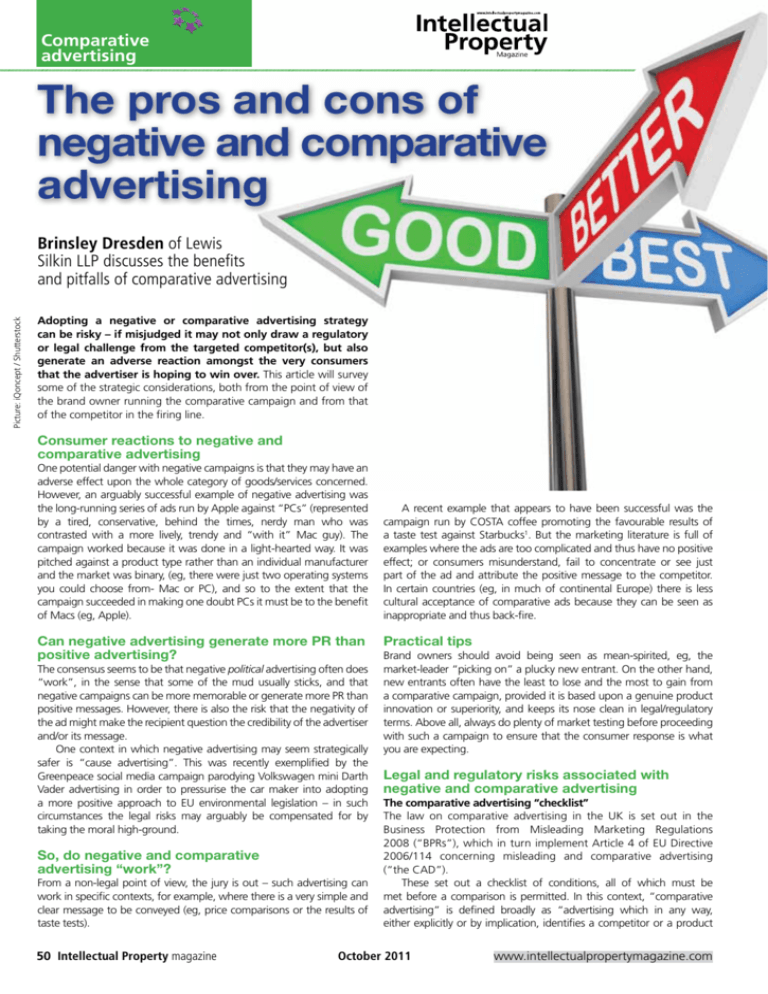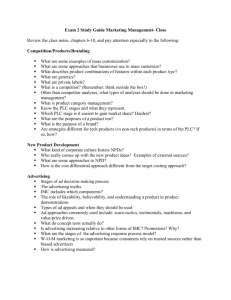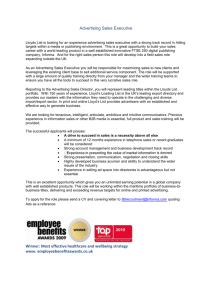The pros and cons of negative and comparative advertising
advertisement

Comparative advertising The pros and cons of negative and comparative advertising Picture: iQoncept / Shutterstock Brinsley Dresden of Lewis Silkin LLP discusses the benefits and pitfalls of comparative advertising Adopting a negative or comparative advertising strategy can be risky – if misjudged it may not only draw a regulatory or legal challenge from the targeted competitor(s), but also generate an adverse reaction amongst the very consumers that the advertiser is hoping to win over. This article will survey some of the strategic considerations, both from the point of view of the brand owner running the comparative campaign and from that of the competitor in the firing line. Consumer reactions to negative and comparative advertising One potential danger with negative campaigns is that they may have an adverse effect upon the whole category of goods/services concerned. However, an arguably successful example of negative advertising was the long-running series of ads run by Apple against “PCs” (represented by a tired, conservative, behind the times, nerdy man who was contrasted with a more lively, trendy and “with it” Mac guy). The campaign worked because it was done in a light-hearted way. It was pitched against a product type rather than an individual manufacturer and the market was binary, (eg, there were just two operating systems you could choose from- Mac or PC), and so to the extent that the campaign succeeded in making one doubt PCs it must be to the benefit of Macs (eg, Apple). Can negative advertising generate more PR than positive advertising? The consensus seems to be that negative political advertising often does “work”, in the sense that some of the mud usually sticks, and that negative campaigns can be more memorable or generate more PR than positive messages. However, there is also the risk that the negativity of the ad might make the recipient question the credibility of the advertiser and/or its message. One context in which negative advertising may seem strategically safer is “cause advertising”. This was recently exemplified by the Greenpeace social media campaign parodying Volkswagen mini Darth Vader advertising in order to pressurise the car maker into adopting a more positive approach to EU environmental legislation – in such circumstances the legal risks may arguably be compensated for by taking the moral high-ground. So, do negative and comparative advertising “work”? From a non-legal point of view, the jury is out – such advertising can work in specific contexts, for example, where there is a very simple and clear message to be conveyed (eg, price comparisons or the results of taste tests). 50 Intellectual Property magazine A recent example that appears to have been successful was the campaign run by COSTA coffee promoting the favourable results of a taste test against Starbucks1. But the marketing literature is full of examples where the ads are too complicated and thus have no positive effect; or consumers misunderstand, fail to concentrate or see just part of the ad and attribute the positive message to the competitor. In certain countries (eg, in much of continental Europe) there is less cultural acceptance of comparative ads because they can be seen as inappropriate and thus back-fire. Practical tips Brand owners should avoid being seen as mean-spirited, eg, the market-leader “picking on” a plucky new entrant. On the other hand, new entrants often have the least to lose and the most to gain from a comparative campaign, provided it is based upon a genuine product innovation or superiority, and keeps its nose clean in legal/regulatory terms. Above all, always do plenty of market testing before proceeding with such a campaign to ensure that the consumer response is what you are expecting. Legal and regulatory risks associated with negative and comparative advertising The comparative advertising “checklist” The law on comparative advertising in the UK is set out in the Business Protection from Misleading Marketing Regulations 2008 (“BPRs”), which in turn implement Article 4 of EU Directive 2006/114 concerning misleading and comparative advertising (“the CAD”). These set out a checklist of conditions, all of which must be met before a comparison is permitted. In this context, “comparative advertising” is defined broadly as “advertising which in any way, either explicitly or by implication, identifies a competitor or a product October 2011 www.intellectualpropertymagazine.com Comparative advertising offered”, which would thus also cover most conceivable types of negative advertising. The Article 4 checklist sets out the following requirements relating to the comparison, if it is to be permitted: a) it is not misleading [by act or omission]; b)it compares goods or services meeting the same needs or intended for the same purpose; c)it objectively compares one or more material, relevant, verifiable and representative features of those goods and services, which may include price; “The consensus seems to be that negative political advertising often does “work”, in the sense that some of the mud usually sticks.” d)it does not discredit or denigrate the trademarks, trade names, other distinguishing marks, goods, services, activities or circumstances of a competitor; e)for products with designation of origin, it relates in each case to products with the same designation; f)it does not take unfair advantage of the reputation of a trademark, trade name or other distinguishing marks of a competitor or of the designation of origin of competing products; g)it does not present goods or services as imitations or replicas of goods or services bearing a protected trademark or trade name; and h)it does not create confusion among traders, between the advertiser and a competitor or between the advertiser’s trademarks, trade names, other distinguishing marks, goods or services and those of a competitor. These conditions have been discussed on a number of occasions by the Court of Justice of the European Union (CJEU), and helpfully summarised by Kitchin J (as he then was) in his recent judgment in Kingspan v Rockwool2. Risks of regulatory or competitor enforcement There is no freestanding private right of action in the UK for a breach of the comparative advertising “checklist” (unlike, for example, in the Republic of Ireland). Regulatory enforcement is by the Office of Fair Trading or Trading Standards (it is a civil, not criminal breach), or by the Advertising Standards Authority (“ASA”) through its enforcement of the Committee of Advertising Practice (CAP) and UK Code of Broadcast Advertising (BCAP Codes3), which contain provisions, that to a large extent, mirror the checklist. In the majority of cases, a disgruntled competitor will first lodge a complaint with the ASA; if the ad is found to be in breach of the codes then an adjudication4 will be issued to that effect, but the impact is largely limited to adverse PR for the advertiser. Negative ads may, however, give a competitor cause for launching a court action in malicious falsehood (if the competitor is referred to in www.intellectualpropertymagazine.com a false or reckless way) or defamation (if there is a suggestion that the competitor is doing something wrong). For run-of-the-mill comparative ads to be able to run a successful civil action, the competitor would have to demonstrate an infringement of its IP rights (see further discussion below) or perhaps argue that non-compliance with the checklist amounted to interference with its business by unlawful means. Types of advertisement that can count as “comparative” for legal/regulatory purposes As mentioned above, there is a wide range of advertising claims that can fall within the definition of “comparative” for the purposes of the “checklist” or the relevant provisions of the CAP and BCAP Codes: • Negative ads, (for example, pointing out faults/negative aspects of a competitor’s product or service rather than simply saying that your own product/service is better). A recent example in the courts was the Kingspan v Rockwool case in which the claimant failed to show malicious falsehood, but won its trademark action having shown that the defendant had not complied with the checklist. The judge found that the defendant’s promotional videos were misleading, failed to properly compare representative features of the competing products, took unfair advantage of and denigrated the claimant’s marks and products. An example from the ASA is its adjudication from 25 June 2008, in which it upheld a complaint from Sage (UK) Ltd. Sage filed a complaint against Interprise Solutions LLP’s direct mail piece and internet banners which read “Sick Of Sage?...” (the SOS message being spelled out in pebbles by a distressed looking office worker on a deserted beach) “...if so, take a look at Interprise Suite”. The ASA held that this ad denigrated Sage and its products, and took unfair advantage of their registered trademark. • Explicit comparisons with named competitors, (demonstrating/ asserting that own product/service is better than one or more named competitor product/service). • Description/promotion of own product/service by reference to competitor product/service. This can amount to “free-riding” if the competitor’s trademarks are used, as in the famous L’Oreal v Bellure5 smell-alike perfumes case. It is an indirect form of comparative advertising, but defendants will often attempt to find a defence by claiming to have complied with the CAD checklist. A further recent example was the ASDA allusion to Specsavers in a strap-line promoting their optician service “be a real spec saver at ASDA”, which the court found to fall on the wrong side of the line in terms of taking unfair advantage of a competitor’s mark. • Implicit comparisons: – Claims to being the best eg, better than all competitors in some aspect of potential comparison. For example, the ASA adjudication from 6 July 2011 upheld a complaint against a claim made by the National Guild of Removers & Storers that “No other organisation or firm comes close to matching the Guild6.” The ASA also upheld the adjudication of 23 March 2011 against 3M which had claimed to be “the world leader in dental cements7”. 3M could show that it was market leader in many markets, but not throughout the world. – “Top parity” claims eg, claims to match the best. An example is a 17 June 2009 complaint upheld by the ASA against GlaxoSmithKline for its claim “Zovirax antiviral cold sore treatment, nothing works faster8”. How should brand-owners react if they are the target of negative or comparative advertising? Should they fight back? The ads may reflect badly on the original advertiser (particularly if “negative”) and it is often better for the brand/product being attacked October 2011 Intellectual Property magazine 51 Comparative advertising To do to retain a dignified silence, while pursuing purely legal/regulatory avenues via ASA/court proceedings. To “fight back” by launching a campaign that directly attacks a negative ad is in itself risky in terms of the consumer reaction, and should not be contemplated without full market testing. Descending to a tit-for-tat response to any comparative ad may generate adverse reaction in itself, as well as drawing greater attention to the original message of the competitor. • Rob ust defen , reliable s ub din Make g both le stantiation gal an sure it is the d k really does regulatory ey to • Obje challe s u pport ctify p nge the c ote succe laims s. ssfully ntially sub made jectiv Starb claim . ec uc e resea ks by bas d their coff laims. Co s rch a in e ta Co e ta g th nd ta ste te e claims o sted bette ffee r sts. n sou • Alth nd m than oug arket raise h compar th iso to su e danger o ns agains bstan tiate t f tradema t named c rk han u o nnam claim, th mpetitors • The ey are ed co ASA’s mpar easie exten shou ison. r ded d ld igital comp check the r emit m ir com arativ ea e, p and s ubmit negative etitors’ we ns advert isers or sim bsites a com ply fo plaint to the misleadin r g ASA if app claims, ropria te How do negative and comparative advertising impact upon intellectual property? On a non-legal level, the value of the advertiser’s (and competitor’s) brands can clearly be impacted for all of the reasons referred to in the first part of this article – this probably goes without saying. “Comparative advertising is in principle encouraged by the CAD/ BPRs as it can stimulate competition and bring out the relative strengths of products to the benefit of consumers.” On a legal level, such advertising can raise potential issues of trademark, copyright and design infringement and passing off (as well as malicious falsehood, defamation and infringement of the CPRs/BPRs) if the advertiser chooses to use the target’s marks, get-up, etc in its ad. However, one of the points that the CAD recognises (as confirmed by case law) is that explicit comparative advertising is impossible without identifying the competitor, and this may necessarily involve at least the use of a registered word mark (the name of the product or service). Such use, if it does not denigrate or take unfair advantage of the mark (see points (d) and (f) of the checklist) can comply with the CAD checklist and thus effectively amount to a defence to trademark infringement. However, the position is less certain when it comes to using the CAD as a defence in respect of logos or designs/get-up etc. Arguably, only use of the word mark is necessary to identify the competitor, and any further encroachment on the target’s IP would be to take unfair advantage. Comparative advertising is in principle encouraged by the CAD/ BPRs as it can stimulate competition and bring out the relative strengths of products to the benefit of consumers (subject to the conditions of the checklist). In this sense, the Anglo-American view of comparative advertising as potentially pro-competitive and beneficial to consumers has triumphed over the continental suspicion of the practice. However, as shown in L’Oreal v Bellure, there are limits to how far the CJEU is willing to push the pro-competition argument. Jacob LJ in the Court of Appeal made it clear that he felt that Bellure should have been allowed to use the L’Oreal marks to describe its smell-alikes, as customers were not confused, but the CJEU disagreed. which claimed the campaign was misleading 2.[2011] EWHC 250 (Ch) at paras 228-232 3.See Section 3.33 et seq in both the CAP and BCAP codes 4.Adjudication is the legal process by which an arbiter or judge reviews evidence and argumentation including legal reasoning set forth by opposing parties or litigants to come to a decision which determines rights and obligations between the parties involved 5.In June 2009, the CJEU found Bellure guilty of free riding and infringement. Bellure used similar packaging and bottles for its imitation fragrances to L’Oreal’s luxury brands. Such use by Bellure was held to amount to trademark infringement because Bellure was taking an unfair advantage of the reputation that L’Oreal had built up in its trademarked packaging and bottles 6.The British Association of Removers (BAR) did not believe the claim could be substantiated and challenged whether it was misleading. http://asa.org. uk/ASA-action/Adjudications/2011/7/National-Guild-of-Removers--Storers/ TF_ADJ_50983.aspx 7.GC UK challenged whether the claim “the world leader in dental cements” was misleading and could be substantiated. http://www.asa.org.uk/ASAaction/Adjudications/2011/3/3M-Health-Care-Ltd/TF_ADJ_49968.aspx 8.Two advert viewers challenged whether the claim “nothing works faster” could be substantiated, because they believed there was a lightemitting device that worked faster. http://www.asa.org.uk/ASA-action/ Adjudications/2009/6/GlaxoSmithKline-plc/TF_ADJ_46409.aspx Footnotes 1.In June 2010, the Advertising Standards Authority (ASA) rejected a complaint by Starbucks over COSTA’s Coffee’s ad campaign that stated “seven out of 10” coffee lovers prefer its coffee. ASA dismissed all of Starbucks grievances 52 Intellectual Property magazine list October 2011 Author Brinsley Dresden is a partner at Lewis Silkin LLP. He is widely recognised as one of the leading advertising and marketing law experts in the UK, dealing with advertising regulation, disputes and commercial contracts. He is also the global vice president and sole UK member of the Global Advertising Lawyers’ Alliance. www.intellectualpropertymagazine.com







